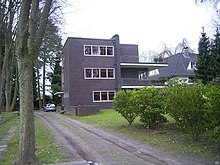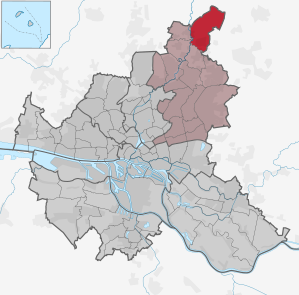Hamburg-Wohldorf-Ohlstedt
|
Wohldorf-Ohlstedt district of Hamburg |
|
|---|---|
| Coordinates | 53 ° 41 '34 " N , 10 ° 7' 52" E |
| surface | 17.3 km² |
| Residents | 4650 (Dec. 31, 2019) |
| Population density | 269 inhabitants / km² |
| Post Code | 22397 |
| prefix | 040 |
| district | Wandsbek |
| Transport links | |
| Subway |
|
| Source: Statistical Office for Hamburg and Schleswig-Holstein | |
Wohldorf-Ohlstedt ( Low German : Woolddborough-Oolsteed ) is now a district of the Free and Hanseatic City of Hamburg in the Wandsbek district . It was merged in 1872 from the Hamburg districts of Ohlstedt in the south and Wohldorf in the north. Ohlstedt is one of the wealthiest districts in Hamburg. The image of this district is predominantly characterized by stately villa properties on spacious, park-like properties. Wohldorf-Ohlstedt is one of the so-called forest villages . These are among the most natural and vegetation-richest residential areas in Hamburg.
history

Ohlstedt was first mentioned in a document in 1292 . Eleven years later, Wohldorf was first mentioned in 1303 . The castle of the manor house in Wohldorf has been documented since 1306. Wohldorf came into the possession of Hamburg citizens in 1370. In 1374 the Hamburg castle complex was destroyed. Ohlstedt was pledged to Hamburg citizens in 1391 and sold to Mayor Hildemar Lopowe in 1407. In 1437 Wohldorf finally became the property of Hamburg, Ohlstedt followed in 1463. In 1471 the Wohldorfer Kornmühle was built and in 1489 the Wohldorf manor house was built, which was replaced by a new building from 1712 to 1714. The Alster lock was built in 1529 at the latest (but possibly as early as the middle of the 15th century), which used to be of considerable importance for Alster shipping (up to 600 locks per year were counted at the end of the 16th century), but today it is only used to regulate water. In 1622 the copper yard in Wohldorf was built as a brass wire mill. Later it served as a whale mill. The building got its current name from its use as a copper hammer since 1686. In the second half of the 19th century a cotton weaving mill was operated there, employing up to 150 workers. After its closure in 1899, Johannes Semler bought the copper yard and converted it into his residence.
The center of the village of Ohlstedter was originally on Ohlstedter Platz, where the yards of the three Vollhufner and the two Halbhufner were. Today's center at the underground station on Alte Dorfstraße was undeveloped until the 18th century. Only then did the newly settled Kätner settle there . With the buildings at Alte Dorfstrasse 19 (from 1834) and Westerfelde 1 (from 1840), two cottages from the 19th century have been preserved. The cottage from 1834 was built for his daughter by Cord Hinrich Buck, a wholesaler from Ohlstedt.
A common village school of Wohldorf and Ohlstedt "Im Busch 8" was built in 1751, but burned down in 1911. 1784 responsible for the Hamburg Walddörfer issued Waldherr stem a permit for the construction of a first "economic and Hökerei" in Ohlstedt, which was built on the old village street. The landlord had to obtain brandy and beer from the "manorial brewery and distillery of the Wohldorfer Hof". Instead of the inn that burned down in 1927 due to lightning strike, there is now a hotel. The Wohldorfer Forest was declared a recreation area in 1770.
The Wohldorfer forge, built in Duvenstedter Triftweg in 1843, was demolished in the 1970s and rebuilt in the Volksdorf museum village . In 1872 the two communities of Wohldorf and Ohlstedt were merged to form the community of Wohldorf-Ohlstedt. The building of today's open-air school on Bredenbekstrasse in Wohldorf was built in 1884 as a restaurant instead of a previous building that had burned down in 1773 and operated until the 1940s. After being used as a military hospital (since 1943) and an old people's home, a primary school was housed there from 1950 for almost twenty years. The volunteer fire brigades in Wohldorf and Ohlstedt was founded in 1894.
Construction of the Alt-Rahlstedt – Volksdorf – Wohldorf (Kleinbahn (EKV)) small electric railway began in 1904. The section between Volksdorf and Wohldorf was opened in May 1907. With the commissioning of the Walddörferbahn extension from Volksdorf to Ohlstedt in 1925, operations to the south were discontinued, the small railway only ran between Wohldorf and Ohlstedt until this remnant was shut down on January 29, 1961. After the plans for a museum railway operation had failed, a hiking trail was built on the route. A memorial was built in the Wohldorfer Forest for the fallen of the First World War . After the topping-out ceremony in 1927, the new town hall of the association was opened in 1928. It also housed a branch of the Hamburger Sparkasse and is still the location of the volunteer fire brigade. After the incorporation into Hamburg through the Greater Hamburg Law in 1938, the post office moved into the building instead of the no longer existing municipal administration for the next 50 years, which is now called "Richard-Timmermann-Haus" after the municipality head during the Weimar period. Also in 1928 an extravagant brick villa was built at Bredenbekstraße 29 based on plans by Karl Schneider . Since the municipal administration was opposed to the construction, the client needed a special permit from the Hamburg construction director Fritz Schumacher . The "Schule am Walde" was built in 1931 in the copper grinder and opened in August of that year. It replaced the old schoolhouse from the 1850s. After a secondary school branch was added in 1997 , it has been a pure elementary and preschool again since the 2011/2012 school year .
During the Second World War , Villa Westphal (also called Neuer Kupferhof ) in Wohldorf , built in 1912/13, was the seat of the overseas radio center for German agent radio . Later it served as a seminar building for the Hamburg administration.
In 1954 the Matthias Claudius Church in Ohlstedt was built and inaugurated on December 4th of that year. Today's sports field of TSV Duwo 08 was built in 1956 on Sthamerstraße. The Duvenstedter Brook has been a nature reserve since 1958 . In 1968 the first telephone exchange of the Federal Post Office in Ohlstedter Strasse was put into operation. In 1971 the Ohlstedt grammar school , which was founded in 1970, moved to temporary pavilions on the grounds of the Schule am Walde, where they stayed for a year before first pavilions and then the first school building on Sthamerstraße were built.
Population development
| year | Residents |
|---|---|
| 1987 | 3693 |
| 1991 | 3770 |
| 1995 | 4018 |
| 2000 | 4085 |
| 2001 | 4156 |
| 2002 | 4229 |
| 2003 | 4241 |
| 2004 | 4260 |
| 2005 | 4335 |
| 2006 | 4402 |
| 2007 | 4419 |
| 2008 | 4395 |
| 2009 | 4392 |
| 2010 | 4437 |
| 2011 | 4450 |
| 2012 | 4423 |
| 2013 | 4433 |
| 2014 | 4475 |
| 2015 | 4823 |
| 2016 | 4656 |
population
The population in Wohldorf-Ohlstedt is made up as follows (data from the North Statistics Office, as of December 2016):
- Total population: 4,656 people
- Minor quota: 21.2%, well above the Hamburg average of 16.2%.
- Share of households with children: 27.8%, well above the Hamburg average of 17.8%.
- Old age quota: 21.3%, is above the Hamburg average of 18.3%.
- Proportion of foreigners: 6.0%, is well below the Hamburg average of 16.7%.
- Share of benefit recipients according to SGBII (Hartz IV): 1.4%, well below the Hamburg average of 10.3%
- Unemployment rate: 1.2%, well below the Hamburg average of 5.3%.
Wohldorf-Ohlstedt is one of the wealthiest districts of Hamburg. The average annual income per taxpayer was around 94,234 euros in 2013 and is significantly higher than the Hamburg average (39,054 euros).
politics
For the election to Hamburg citizenship , Wohldorf-Ohlstedt belongs to the Alstertal-Walddörfer constituency . The 2015 state election led to the following result:
- SPD 38.5% (−0.2)
- CDU 20.8% (−6.5)
- Greens 14.9% (−0.2)
- FDP 14.5% (+0.4)
- AfD 4.7% (+4.7)
- Left 4.1% (+1.7)
- Remaining 2.5% (+0.1)
Institutions and public bodies
In Wohldorf-Ohlstedt there is the Haselknick grill and playground near the Ohlstedter Alsterwiesen, an underground station, the TSV Duwo 08 sports club , two schools, a Protestant church (Matthias Claudius Church) and a forest cemetery. There are also various private institutions. In addition to a bank and a few shops, there is also a pub, an ice cream parlor and a hotel restaurant.
schools
There are two schools in Wohldorf-Ohlstedt, the "Schule am Walde" (pre-school and elementary school) and the Ohlstedt high school . The "Schule am Walde" has two to three classes, the Gymnasium Ohlstedt mostly four classes.
Voluntary fire brigades
In Wohldorf-Ohlstedt there are two volunteer fire departments: the Wohldorf volunteer fire department and the Ohlstedt volunteer fire department . Since Wohldorf-Ohlstedt is on the outskirts of Hamburg, the FF Wohldorf and FF Ohlstedt are also first responders .
traffic
The small electric railway Alt-Rahlstedt – Volksdorf – Wohldorf reached Wohldorf in 1907 and Ohlstedt in 1925. The line has since been closed .
See also
- List of streets, squares and bridges in Hamburg-Wohldorf-Ohlstedt
- List of cultural monuments in Hamburg-Wohldorf-Ohlstedt
- List of stumbling blocks in Hamburg-Wohldorf-Ohlstedt
Individual evidence
- ↑ a b c d e f g h Alf Schreyer: Traces of the past in Wohldorf / Ohlstedt. In: 75 years - Duwo 08 - 1908–1983. Festive edition of the Duwo-Post for the 75th anniversary 1983, Hamburg 1983, p. 11 ff.
- ^ History of the Gymnasium Ohlstedt | Ohlstedt high school. Accessed January 2, 2019 (German).
- ^ Statistics Office North, Hamburg District Profiles, reporting year 2016, pages 162–163; Data status December 31, 2016 (accessed February 8, 2018)
- ↑ wahlen-hamburg.de
- ↑ Wohldorf volunteer fire brigade
- ^ Ohlstedt volunteer fire brigade
literature
- Alf Schreyer: Wohldorf and Ohlstedt. M + K Hansa-Verlag, Hamburg 1971, ISBN 3-920610-05-X .
- Alf Schreyer: Traces of the past in Wohldorf / Ohlstedt. In: 75 years - Duwo 08 - 1908–1983. Festive edition of the Duwo-Post for the 75th anniversary 1983. Hamburg 1983, p. 11 ff.





